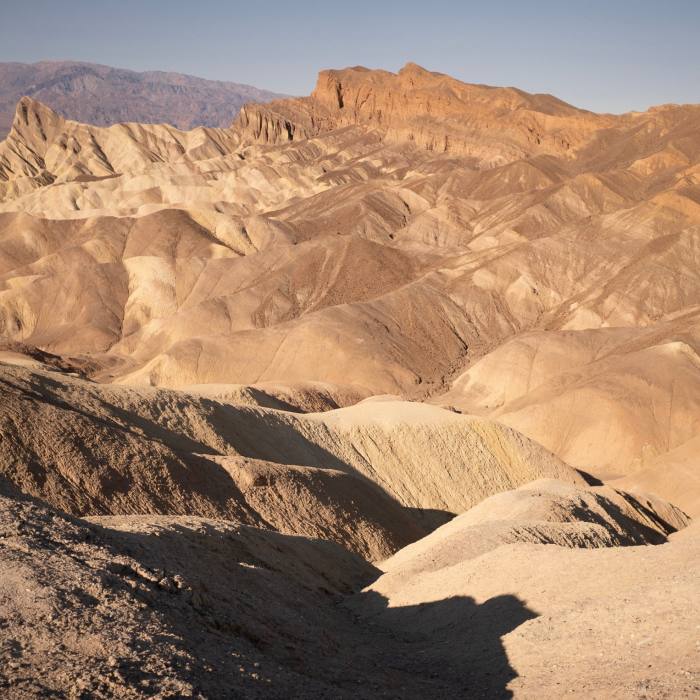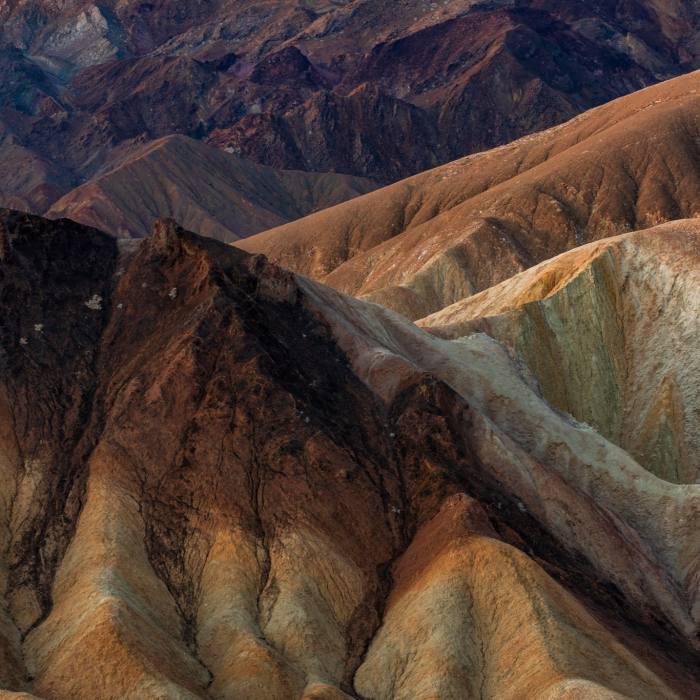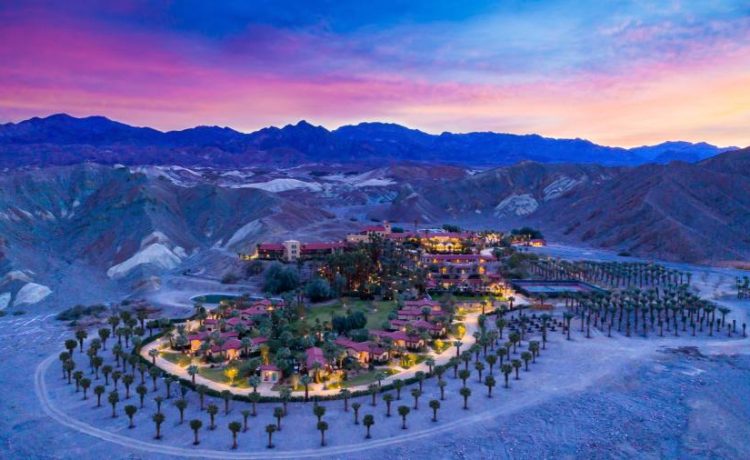Richard Farabee is a seen-it-all-before westerner who sizes you up with narrowed eyes and then reveals his verdict in one laconic line. He is, for me, what makes America great.
He rents jeeps out of Furnace Creek in Death Valley so you can explore the rocky trails that climb from each side of the Californian national park’s anvil-hard floor.
“I rented a jeep to a bunch of boys who rolled the thing down a steep slope,” he says. “They managed to get it back on its wheels and then drove it to a bar. My son saw it there, all mangled up, went inside and told them, ‘You can’t be doing that, fellas’.”
But that was elsewhere. Death Valley’s trails are easier, he says, “starter jeeping”, which is fine because he loves first timers. He gazes at my pal David and I and suggests a few trails. We take the keys and head off, soon to scare the bejesus out of ourselves.


It’s a good ol’ American name, Death Valley, coined by prospectors in a time before euphemism. As the altitude drops to sea-level and then keeps falling, the dusty mountains spread out to create a landscape with the colour, texture and weight of perdition.
I had landed in Los Angeles a couple of nights before, and there was a smattering of snow in the canyons as I drove up through Bel Air that morning. I had agreed to meet David in the Trails Drive In in the desert town of Trona. Four hours on, it turned out to be a blasted sort of place, famed for the school football team having to play on dirt.
I waited with a chilli dog and an ice cream soda for David to pull up. We hugged in that slightly giddy way of very old friends on an adventure. “So how do you want to approach this?” he asked. “We can just stick to the highway or we can take the backroads?” Obviously, there was only one right answer.

As we drove on, the blacktop ran across Panamint Valley floor, creosote scrub on each side like stubble on a sun-scoured face. Thin clouds clung to the edging mountains to avoid extinction in the blue above. And then we turned and began to climb into the hills. We entered Death Valley National Park, and the names began to conjure men scratching at an eternal land: Charcoal Kilns, Rattlesnake Gulch.
In Emigrant Canyon among the peaks, the day’s end ran as shadow across the land. At 5,000 feet in December, it was chilly. The beer we shared in the last of the sun felt too cold.
Death Valley National Park spans 3.4mn acres but, unless you want to camp, there are just three places to stay: the hotels at Panamint Springs and Stovepipe Wells and the much larger Oasis at Death Valley, in Furnace Creek.
The Oasis dates back to 1927, when the Pacific Coast Borax Company diversified into tourism by opening a 12-room inn, six years before Death Valley was designated a national monument. Today it is made up of two hotels, The Inn and The Ranch, which emerged last summer from a $150mn, five-year renovation project. Both are run by Xanterra, a hospitality company that is owned by Philip Anschutz, a Christian conservative billionaire.
It was after dark when we arrived in front of the Ranch. The facade is ye olde west, The Last Kind Words Saloon is located to one side with a series of buildings sprawling away.


I told the receptionist we were booked at The Inn. “That’s the fancy one up the road,” she replied. We drove on before I realised I was wrong. We had one of the 80 new cottages at the Ranch, part of the renovation.
While none of the $150mn has seemingly been spent on an exciting architect, our cottage is fine, a muscled up motel room. David was on the sofa bed which, when we pulled it out, was a little grubby. I wandered back to reception and asked if they could make it up. “Well, we wouldn’t normally . . . ” came the reply, left hanging there.
I was keen to come partly because there seems to be a renaissance in the big American resorts. Ocean House in Rhode Island, established 1868, has just been renovated at a cost of $146mn. In Florida, the Boca Raton, with a marina and golf course, has just had $200mn spent on it. I am hoping for a 2020s’ version of Dirty Dancing some time soon.
Xanterra controls everything in Furnace Creek except the Native American village. There is golf and horse riding, and America’s most remote ice-cream parlour (although they include the caveat “perhaps”). At The Inn, there’s a spa and geothermal pool.


And, of course, there’s what lies all around. Both The Inn and The Ranch sit in genuine oases that give out to the sublime, terrifying beauty of Death Valley. The oases, which are about 190 feet below sea level, were occupied for a millennium by the Native American tribe Timbisha Shoshone before incoming miners and the government pushed them out into the cauldron.
The Shoshone called the valley tumpisa, which means “red ochre”. The landscape is so extreme that it warps reality. What looks like snow is efflorescence, a dusting of salt on the surface. Shafts of rain evaporate before they touch down.
And, of course, it’s hot. In 1913, the air temperature apparently (there’s some dispute) reached 56.7C, making it the warmest place on Earth. The highest ever surface temperature was recorded at Furnace Creek in 1972, at 93.3C.
Which all leads to strange behaviour, not least among visiting Saxons. A friend who came one July said he walked into Furnace Creek gas station and the attendant asked: “Are you German or British?” He was then handed a carton of eggs.
“C’mon,” the attendant said to his surprised look. “We both know you’re going to fry them on the top of your hire car.”
David and I set off in Richard’s pumped-up Jeep Wrangler. It comes with satellite beacons, water and all that good stuff. Soon we’re creating a dust trail on the Echo Canyon track, heading up past the Eye of the Needle (a hole in the rock wall) to the Inyo mine.
As we look at the debris spread around the mine, David says his neighbour in Joshua Tree is a cop employed to protect such rusting bits of metal as historic artefacts. Meanwhile I tell him that Death Valley has its own fish, the pupfish, that have survived in two saline spots since the last Ice Age.



We take a separate track and reach a sketchy bit of trail that involves the jeep climbing a rocky ledge. Back to being small boys, we’re immediately egging each other on.
One plays spotter — this is a technical “jeeping” term — while the other handles the jeep. Richard said spotter is the tougher job as he or (more usually) she is always the one who gets squashed. At several moments we only have three wheels anywhere near the surface.
Having suitably thrilled ourselves, we take another of Richard’s suggestions, and go for height, following a trail to a 5,000ft ridge and Chloride City, a ghost town.
The sun is falling, throwing the valley and its towering tops (Telescope Peak on the other side rises to 11,043 feet) into a frenzy of colour. The old miners’ camp is sobering — just the thought of being out here day after day, working in one of the dark holes that disappear into the earth, makes me feel soft and very lucky.



To push the point, and make the valley’s name more real, there is a grave that belongs to James McKay of whom, later searching on the National Park Service website tells me, “nothing is known”, which is quite the epitaph.
The following morning, I move to The Inn and David heads home. The staff are friendlier. There are 66 rooms in the hotel and 22 new casitas, larger and set in lush grounds. I have a room of dark woods and mauve walls in the main building, looking over palm trees, the geothermal pool and the red earth of the valley beyond. I wander down to the new spa, to meet Heather Williams.
Heather is thrilled to see me (the people who operate the concessions — the horse riding, the spa and Farabee’s jeeps — are all magnificent). She puts together a sort of super massage in her “sanctuary”. At one point I am a burrito wrapped in hot plastic and sauced with camel milk.
“It’s beautiful here,” Heather says. She’s religious and often communes with God in the valley. “You can come here to put to death things you don’t want in your life anymore. Everyone should experience the silence and solitude.”
Staggering out, I drive down to Badwater, at 282 feet below sea-level the lowest point in North America. Salt covers the valley floor and the cool winter sun makes kaleidoscopes on the valley walls.

Feeling a little gouged by a piece of halibut for $70 (incl tax and tip) in The Inn’s Bavarian-themed dining room, I decide to check out alternative accommodation. There’s not much. I drive south for an hour to Villa Anita, in Tecopa, just outside the park boundary, where my niece had spent a summer helping out.
It turns out to be a trailer park art installation with eccentric rooms culminating in one made of bottles. Carlo Roncancio, a photographer who had nightclubs in Los Angeles and Las Vegas, greets me with a vast hello.
He decides immediately (and preposterously) that I look like Robert Redford and insists on recreating the final scene of The Way We Were, with him in the role of Barbra Streisand. He pulls on a black leather glove and runs his hand through my hair, whispering: “Your girl is lovely, Hubbell.”
This is in the first 15 minutes. Carlo turns out to be another American who makes his country great. I find myself laughing for three hours. But after an excellent soup cooked by his partner Jack, I head back to The Inn.
Above me the universe is aflame with stars, ahead of me the road snakes north. I start to grin. It’s true that the Oasis might be a touch antiseptic, overpriced and gauche, but I realise I’m looking forward to the impersonal comfort of my room in the middle of this fiery valley.
Details
Ruaridh Nicoll was a guest of Visit California (visitcalifornia.com) and The Oasis at Death Valley (oasisatdeathvalley.com). Double rooms start at $279 at The Ranch and $409 The Inn; Richard Farabee’s jeeps start at $345 (farabeejeeps.com); Heather Williams Sanctuary can be found at sanctuaryatdv.com and Villa Anita at villaanitadv.com
Find out about our latest stories first — follow @ftweekend on Twitter




